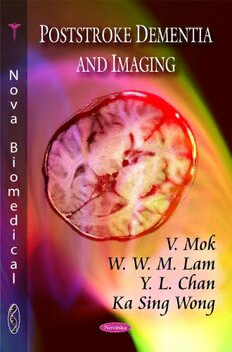Download Poststroke Dementia and Imaging PDF Free - Full Version
Download Poststroke Dementia and Imaging by V. Vok, W. M. Lam, Y. L. Chan, Ka Sing Wong in PDF format completely FREE. No registration required, no payment needed. Get instant access to this valuable resource on PDFdrive.to!
About Poststroke Dementia and Imaging
Stroke increases the risk of dementia by approximate 2-9 times. World wide, vascular dementia (VaD) is the second commonest cause of dementia. Presence of post-stroke dementia (PSD) reduces survival among stroke survivors and increases risk of long term stroke recurrence. Varying severity levels of cognitive impairment affects functional outcome independent of physical impairment. With an ageing population, burden of PSD is expected to rise. Although PSD is prevalent, relevant to mortality and morbidity, and is potentially more preventable than Alzheimer's disease (AD), it has received less attention relative to post-stroke physical impairment or to AD. It is not until the last decade that more attention has been paid to PSD. Historically, in the late 19th century, VaD was considered to be the commonest cause of dementia. It was thought that dementia was due to a relentless strangulation of the brain's blood supply, resulting in degeneration of the brain and dementia.In the middle of the 20th century, pathological studies have begun to reveal that senile plaques and neurofibrillary tangles, rather than vascular lesions, were key findings among most of the elderly demented patients with atrophic brains. In the early 70s, VaD was thought to be uncommon and the mechanism of VaD was attributed to multiple small or large cerebral infarcts (multi-infarct dementia). In recent decades, advances of neuroimaging have enhanced greatly our understanding on VaD, its complexity far exceeds that of the concept of multi-infarct dementia. The authors aim to review the current understanding of PSD and its imaging. Poststroke dementia will first be defined. Following that, foundational issues of PSD including its classification, pathology, prevalence, and cognitive pattern will be reviewed. This sets the background for discussing the imaging aspects relevant to PSD.
Detailed Information
| Author: | V. Vok, W. M. Lam, Y. L. Chan, Ka Sing Wong |
|---|---|
| Publication Year: | 2009 |
| ISBN: | 9781608764228 |
| Pages: | 107 |
| Language: | English |
| File Size: | 1.103 |
| Format: | |
| Price: | FREE |
Safe & Secure Download - No registration required
Why Choose PDFdrive for Your Free Poststroke Dementia and Imaging Download?
- 100% Free: No hidden fees or subscriptions required for one book every day.
- No Registration: Immediate access is available without creating accounts for one book every day.
- Safe and Secure: Clean downloads without malware or viruses
- Multiple Formats: PDF, MOBI, Mpub,... optimized for all devices
- Educational Resource: Supporting knowledge sharing and learning
Frequently Asked Questions
Is it really free to download Poststroke Dementia and Imaging PDF?
Yes, on https://PDFdrive.to you can download Poststroke Dementia and Imaging by V. Vok, W. M. Lam, Y. L. Chan, Ka Sing Wong completely free. We don't require any payment, subscription, or registration to access this PDF file. For 3 books every day.
How can I read Poststroke Dementia and Imaging on my mobile device?
After downloading Poststroke Dementia and Imaging PDF, you can open it with any PDF reader app on your phone or tablet. We recommend using Adobe Acrobat Reader, Apple Books, or Google Play Books for the best reading experience.
Is this the full version of Poststroke Dementia and Imaging?
Yes, this is the complete PDF version of Poststroke Dementia and Imaging by V. Vok, W. M. Lam, Y. L. Chan, Ka Sing Wong. You will be able to read the entire content as in the printed version without missing any pages.
Is it legal to download Poststroke Dementia and Imaging PDF for free?
https://PDFdrive.to provides links to free educational resources available online. We do not store any files on our servers. Please be aware of copyright laws in your country before downloading.
The materials shared are intended for research, educational, and personal use in accordance with fair use principles.

